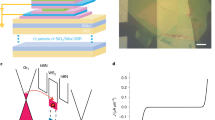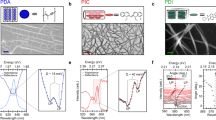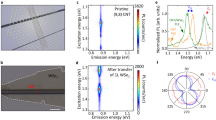Abstract
Exciton-polaritons are hybrid light–matter particles that form upon strong coupling of an excitonic transition to a cavity mode. As bosons, polaritons can form condensates with coherent laser-like emission. For organic materials, optically pumped condensation was achieved at room temperature but electrically pumped condensation remains elusive due to insufficient polariton densities. Here we combine the outstanding optical and electronic properties of purified, solution-processed semiconducting (6,5) single-walled carbon nanotubes (SWCNTs) in a microcavity-integrated light-emitting field-effect transistor to realize efficient electrical pumping of exciton-polaritons at room temperature with high current densities (>10 kA cm−2) and tunability in the near-infrared (1,060 nm to 1,530 nm). We demonstrate thermalization of SWCNT polaritons, exciton-polariton pumping rates ∼104 times higher than in current organic polariton devices, direct control over the coupling strength (Rabi splitting) via the applied gate voltage, and a tenfold enhancement of polaritonic over excitonic emission. This powerful material–device combination paves the way to carbon-based polariton emitters and possibly lasers.
This is a preview of subscription content, access via your institution
Access options
Access Nature and 54 other Nature Portfolio journals
Get Nature+, our best-value online-access subscription
$29.99 / 30 days
cancel any time
Subscribe to this journal
Receive 12 print issues and online access
$259.00 per year
only $21.58 per issue
Buy this article
- Purchase on Springer Link
- Instant access to full article PDF
Prices may be subject to local taxes which are calculated during checkout





Similar content being viewed by others
References
Kasprzak, J. et al. Bose–Einstein condensation of exciton polaritons. Nature 443, 409–414 (2006).
Amo, A. et al. Superfluidity of polaritons in semiconductor microcavities. Nat. Phys. 5, 805–810 (2009).
Sanvitto, D. & Kéna-Cohen, S. The road towards polaritonic devices. Nat. Mater. 15, 1061–1073 (2016).
Dreismann, A. et al. A sub-femtojoule electrical spin-switch based on optically trapped polariton condensates. Nat. Mater. 15, 1074–1078 (2016).
Schneider, C. et al. An electrically pumped polariton laser. Nature 497, 348–352 (2013).
Bhattacharya, P. et al. Room temperature electrically injected polariton laser. Phys. Rev. Lett. 112, 236802 (2014).
Kéna-Cohen, S. & Forrest, S. R. Room-temperature polariton lasing in an organic single-crystal microcavity. Nat. Photon. 4, 371–375 (2010).
Plumhof, J. D., Stöferle, T., Mai, L., Scherf, U. & Mahrt, R. F. Room-temperature Bose–Einstein condensation of cavity exciton–polaritons in a polymer. Nat. Mater. 13, 247–252 (2014).
Daskalakis, K. S., Maier, S. A., Murray, R. & Kéna-Cohen, S. Nonlinear interactions in an organic polariton condensate. Nat. Mater. 13, 271–278 (2014).
Dietrich, C. P. et al. An exciton-polariton laser based on biologically produced fluorescent protein. Sci. Adv. 2, e1600666 (2016).
Gubbin, C. R., Maier, S. A. & Kéna-Cohen, S. Low-voltage polariton electroluminescence from an ultrastrongly coupled organic light-emitting diode. Appl. Phys. Lett. 104, 233302 (2014).
Christogiannis, N. et al. Characterizing the electroluminescence emission from a strongly coupled organic semiconductor microcavity LED. Adv. Opt. Mater. 1, 503–509 (2013).
Bisri, S. Z., Takenobu, T. & Iwasa, Y. The pursuit of electrically-driven organic semiconductor lasers. J. Mater. Chem. C 2, 2827–2836 (2014).
Tsotsis, P. et al. Tuning the energy of a polariton condensate via bias-controlled Rabi splitting. Phys. Rev. Appl. 2, 014002 (2014).
Tsintzos, S. I., Pelekanos, N. T., Konstantinidis, G., Hatzopoulos, Z. & Savvidis, P. G. A GaAs polariton light-emitting diode operating near room temperature. Nature 453, 372–375 (2008).
Shiny condensates. Nat. Mater. 15, 1047 (2016).
Fraser, M. D., Höfling, S. & Yamamoto, Y. Physics and applications of exciton–polariton lasers. Nat. Mater. 15, 1049–1052 (2016).
Graf, A., Tropf, L., Zakharko, Y., Zaumseil, J. & Gather, M. C. Near-infrared exciton-polaritons in strongly coupled single-walled carbon nanotube microcavities. Nat. Commun. 7, 13078 (2016).
Schießl, S. P. et al. Polymer-sorted semiconducting carbon nanotube networks for high-performance ambipolar field-effect transistors. ACS Appl. Mater. Interfaces 7, 682–689 (2015).
Khasminskaya, S. et al. Fully integrated quantum photonic circuit with an electrically driven light source. Nat. Photon. 10, 727–732 (2016).
Soavi, G., Scotognella, F., Lanzani, G. & Cerullo, G. Ultrafast photophysics of single-walled carbon nanotubes. Adv. Opt. Mater. 11, 1670–1688 (2016).
Nguyen, D. T. et al. Elastic exciton-exciton scattering in photoexcited carbon nanotubes. Phys. Rev. Lett. 107, 127401 (2011).
Iwamura, M. et al. Nonlinear photoluminescence spectroscopy of carbon nanotubes with localized exciton states. ACS Nano 8, 11254–11260 (2014).
Graf, A. et al. Large scale, selective dispersion of long single-walled carbon nanotubes with high photoluminescence quantum yield by shear force mixing. Carbon 105, 593–599 (2016).
Blackburn, J. L., Holt, J. M., Irurzun, V. M., Resasco, D. E. & Rumbles, G. Confirmation of K-momentum dark exciton vibronic sidebands using 13 C-labeled, highly enriched (6,5) single-walled carbon nanotubes. Nano Lett. 12, 1398–1403 (2012).
Orgiu, E. et al. Conductivity in organic semiconductors hybridized with the vacuum field. Nat. Mater. 14, 1123–1129 (2015).
Gwinner, M. C. et al. Highly efficient single-layer polymer ambipolar light-emitting field-effect transistors. Adv. Mater. 24, 2728–2734 (2012).
Grant, R. T. et al. Efficient radiative pumping of polaritons in a strongly coupled microcavity by a fluorescent molecular dye. Adv. Opt. Mater. 4, 1615–1623 (2016).
Ballarini, D. et al. Polariton-induced enhanced emission from an organic dye under the strong coupling regime. Adv. Opt. Mater. 2, 1076–1081 (2014).
Coles, D. M. et al. Vibrationally assisted polariton-relaxation processes in strongly coupled organic-semiconductor microcavities. Adv. Funct. Mater. 21, 3691–3696 (2011).
Somaschi, N. et al. Phonon-driven resonantly enhanced polariton luminescence in organic microcavities. Proc. SPIE 8260, 82600Q (2012).
Lagoudakis, P. G. et al. Electron-polariton scattering in semiconductor microcavities. Phys. Rev. Lett. 90, 206401 (2003).
Rother, M., Schießl, S. P., Zakharko, Y., Gannott, F. & Zaumseil, J. Understanding charge transport in mixed networks of semiconducting carbon nanotubes. ACS Appl. Mater. Interfaces 8, 5571–5579 (2016).
Coles, D. M. et al. Polariton-mediated energy transfer between organic dyes in a strongly coupled optical microcavity. Nat. Mater. 13, 712–719 (2014).
Nikiforov, G. O. et al. Current-induced joule heating and electrical field effects in low temperature measurements on TIPS pentacene thin film transistors. Adv. Electron. Mater. 2, 1600163 (2016).
Balandin, A. A. Thermal properties of graphene and nanostructured carbon materials. Nat. Mater. 10, 569–581 (2011).
Tischler, J. R., Bradley, M. S., Bulović, V., Song, J. H. & Nurmikko, A. Strong coupling in a microcavity LED. Phys. Rev. Lett. 95, 036401 (2005).
Jakubka, F., Grimm, S. B., Zakharko, Y., Gannott, F. & Zaumseil, J. Trion electroluminescence from semiconducting carbon nanotubes. ACS Nano 8, 8477–8486 (2014).
Hartleb, H., Späth, F. & Hertel, T. Evidence for strong electronic correlations in the spectra of gate-doped single-wall carbon nanotubes. ACS Nano 9, 10461–10470 (2015).
Lidzey, D. G. et al. Strong exciton-photon coupling in an organic semiconductor microcavity. Nature 395, 53–55 (1998).
Rapaport, R. et al. Negatively charged quantum well polaritons in a GaAs/AlAs microcavity: an analog of atoms in a cavity. Phys. Rev. Lett. 84, 1607–1610 (2000).
Rapaport, R., Cohen, E., Ron, A., Linder, E. & Pfeiffer, L. N. Negatively charged polaritons in a semiconductor microcavity. Phys. Rev. B 63, 235310 (2001).
Sidler, M. et al. Fermi polaron-polaritons in charge-tunable atomically thin semiconductors. Nat. Phys. 13, 255–261 (2016).
Laussy, F. P., Kavokin, A. V. & Shelykh, I. A. Exciton-polariton mediated superconductivity. Phys. Rev. Lett. 104, 106402 (2010).
Malpuech, G. et al. Polariton lasing due to the exciton-electron scattering in semiconductor microcavities. Phys. Status Solidi 190, 181–186 (2002).
Venkateshvaran, D. et al. Approaching disorder-free transport in high-mobility conjugated polymers. Nature 515, 384–388 (2014).
Bajoni, D. Polariton lasers. Hybrid light–matter lasers without inversion. J. Phys. D 45, 313001 (2012).
Liu, X. et al. Strong light–matter coupling in two-dimensional atomic crystals. Nat. Photon. 9, 30–34 (2014).
Acknowledgements
This research was financially supported by the European Research Council under the European Union’s Seventh Framework Programme (FP/2007-2013)/ERC Grant Agreement No. 306298 (EN-LUMINATE) and under the European Union’s Horizon 2020 Framework Programme (FP/2014-2020)/ERC Grant Agreement No. 640012 (ABLASE) and by the Scottish Funding Council (through SUPA). L.T. thanks the EPSRC for support through the CM-DTC (EP/L015110/1). J.Z. thanks the Alfried Krupp von Bohlen und Halbach-Stiftung via the ‘Alfried Krupp Förderpreis für junge Hochschullehrer’ for general support.
Author information
Authors and Affiliations
Contributions
A.G. and M.H. performed the experiments, simulations and analysed the data. Y.Z. assisted with interpretation and data analysis. L.T. contributed to the simulations. A.G., M.C.G. and J.Z. jointly wrote the manuscript. M.C.G. and J.Z. conceived and supervised the project. All authors discussed the results and commented on the manuscript.
Corresponding authors
Ethics declarations
Competing interests
The authors declare no competing financial interests.
Supplementary information
Supplementary Information
Supplementary Information (PDF 2749 kb)
Supplementary Movie
Supplementary Movie (AVI 17871 kb)
Rights and permissions
About this article
Cite this article
Graf, A., Held, M., Zakharko, Y. et al. Electrical pumping and tuning of exciton-polaritons in carbon nanotube microcavities. Nature Mater 16, 911–917 (2017). https://doi.org/10.1038/nmat4940
Received:
Accepted:
Published:
Issue Date:
DOI: https://doi.org/10.1038/nmat4940
This article is cited by
-
Barrier-free reverse-intersystem crossing in organic molecules by strong light-matter coupling
Nature Communications (2021)
-
Colloidal quantum dot lasers
Nature Reviews Materials (2021)
-
Prospects and challenges of colloidal quantum dot laser diodes
Nature Photonics (2021)
-
A room-temperature polariton light-emitting diode based on monolayer WS2
Nature Nanotechnology (2019)
-
Continuous transition between weak and ultrastrong coupling through exceptional points in carbon nanotube microcavity exciton–polaritons
Nature Photonics (2018)



